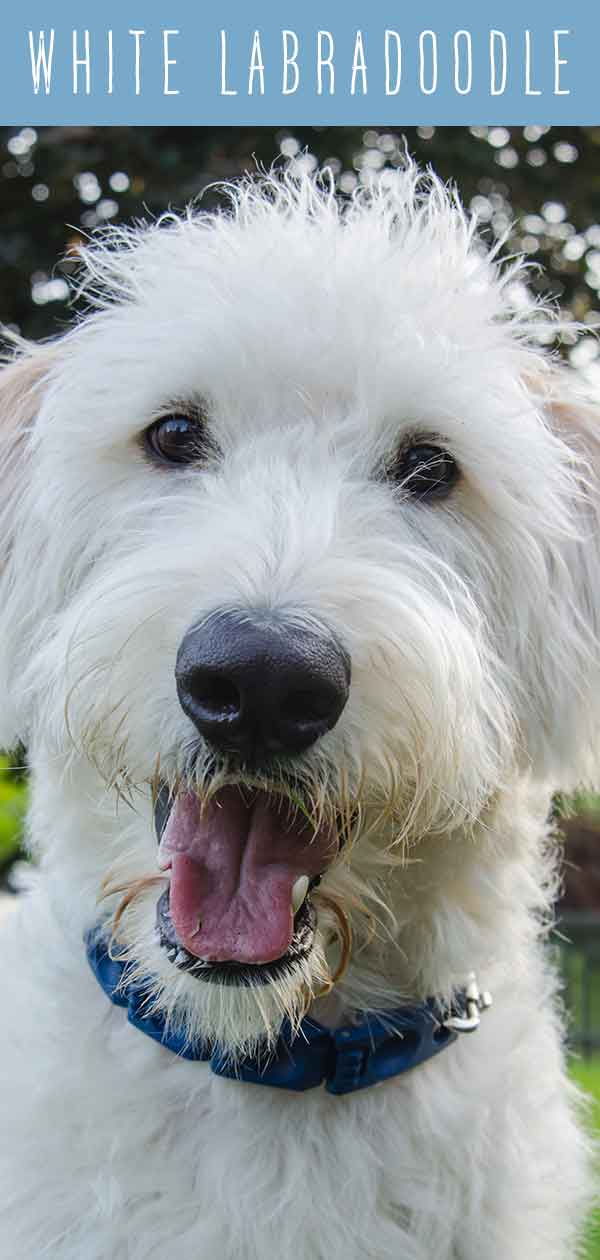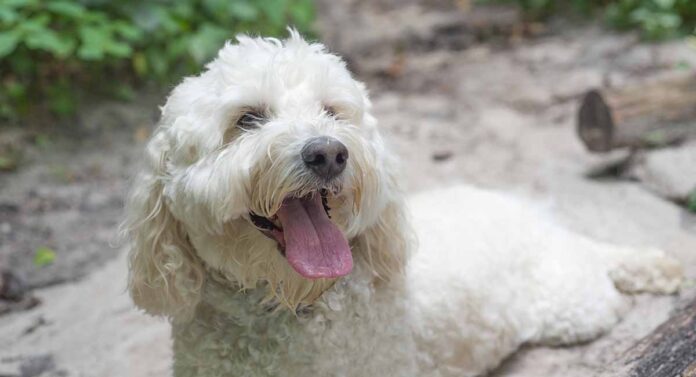The white Labradoodle is a Labrador Retriever and Poodle mix dog, with a chalky coat. White Labradoodle puppies inherit their snowy fur from the Poodle parent. This coat color isn’t caused by the albinism gene, and your pale Labradoodle puppy will have dark irises, eye rims and claws.
- Where they come from.
- Expectations of friendliness and trainability.
- White Labradoodle health implications.
White Coats and Important Jobs?
The Labradoodle is what’s known as a designer dog. This term refers to when breeds combine to accentuate the best traits in both breeds. The Labradoodle stemmed from the need for an allergy-friendly assistance dog.
Poodles have somewhat hypoallergenic coats, in that they don’t shed or produce much dandruff. Unfortunately, they couldn’t muster up the discipline needed to be an efficient service dog.
Labrador Retrievers, on the other hand, make perfect assistance dogs. But their fur sheds and holds dander that aggravates allergies. That makes it difficult for anyone who has allergies in their household.

White Labradoodle Genetics
Let’s look deeper into the genetics of dogs, and specifically white Labradoodles. All color found on dogs comes from two different pigments. There’s eumelanin, which is black, or pheomelanin, which is red. As dogs grow, cells called melanocytes add these two melanins to their hair. The amount of melanin that gets added will determine a dog’s coat color.
When a dog has a white coat, it’s actually a result of a lack of pigmentation. There is still pigmentation in the nose and they eyes, but none in the fur. Pigmentation in the eyes and nose is what officially qualifies white Labradoodles according to the ALAA. This pigmentation also sets white Labradoodles apart from dogs with albinism. Albinism is the complete lack of pigmentation.
How White Labradoodles Inherit Their Color
White is a recognized color for Poodles, but not Labrador Retrievers. White Poodles get their color (or lack of it) from the S gene. Labradors do not carry the S gene. Although very occasionally they might have small areas of the white trim in their coat. So, white Labradoodles always inherit their color from their Poodle parent.
Labradoodle Temperament
It can be difficult to pinpoint the personality of a mixed breed dog. You can’t predict whether they’ll be more influenced by the Labrador genes or Poodle genes. Both breeds are known as family-friendly dogs. Labradoodles can be high-energy and friendly. How friendly they are will depend on whether they take after the Poodle or Labrador parent more.
Poodles seem to be a bit more aloof, whereas Labradors are often extremely friendly. And your Labradoodle’s temperament could fall anywhere on this spectrum. You can help temperament with proper socialization, adequate exercise and lots of attention. Labradors are social dogs who don’t do well with long periods of alone time.
To get an idea of the temperament your dog might have, ask your breeder about the parents’ temperament. While this can’t guarantee how your Labradoodle will behave, it can give you an idea of what to expect.
With all that said, there is currently no real evidence that coat color affects a dog’s temperament. So while your dog might be more Labrador or more Poodle-like, their white fur won’t dictate their personality.
Labradoodle Health
Every breed of dog will have their own health risks. So it’s important to know what may arise with your White Labradoodle. It’s essential for you to talk with your breeder about your dog’s lineage and confirm health testing. Many issues that could arise are genetic. Reputable breeders won’t let those conditions continue if they can help it. Since your Labradoodle has Labrador and Poodle genes, it’s important to know the risks on both sides.
There are several issues that Poodles and Labradors have in common since they’re both large dogs. Here are some of the health concerns that they share. These include hip dysplasia, bloat and progressive retinal atrophy.
Poodles are also prone to Addison’s disease, von Willebrand’s, epilepsy and sebaceous adentitis. However none of these issues are directly connected to coat color.
White Labradoodle Health Issues
The color of your Labradoodle may not influence your dog’s temperament, but it does have a say in their health. As we talked about earlier, it’s a lack of melanin that causes the white coat.
Melanocytes also influence the cells of a dog’s inner ear canal. If a dog lacks these melanocytes, it will also lack the proper hearing cells. This will result in a high chance of congenital deafness.
Melanin also influences how a dog’s eyes filter light. This makes your White Labradoodle more susceptible to poor eyesight than other colors. Their white coat also means they likely have sensitive skin. Their time in the sun should be closely monitored.
Labradoodle Coat and Grooming Requirements
Labradoodle coats are hardly low maintenance. Since there’s such a difference between Labrador and Poodle coats, there are a number of possibilities for your dog’s coat.
Your dog’s coat will depend on which parent’s genes are dominant. It could have the thick, curly wool-like fur of a Poodle. They may also have loose (or no) curls, with a lot more shedding.
You will need to brush your Labradoodle once or twice weekly. If they shed like Labradors, they’ll need more care during high shedding season. This may even mean daily brushing. They will need regular clipping to keep the coat from matting. A fine-tooth comb, brush, and detangling spray will help you care for them.
White Coat Care
As with most things, white means even more maintenance. White fur may mean your dog has sensitive skin. You don’t want to overwash them and cause dryness and irritation.
Choose a gentle shampoo, and keep full baths to a minimum. If your white Labradoodle gets dirty, wait until the dirt is dry and brush it out. You can also use cleaning cloths to remove stains. Pay special attention to areas prone to staining: around the eyes and mouth.
Selecting a Reputable Breeder
Lastly, regardless of coat color or breed, you should always look for a reputable breeder. Good breeders work towards the betterment of the species and the breed. They take important qualities such as health, temperament and more into account.
But you’re likely to come across a lot of backyard breeders in the looking process. These breeders are looking for quick money. So they take advantage of the popularity of designer breeds like Labradoodles. They do this by over-breeding dogs. And they don’t consider the mother’s health or the genetic qualities of the puppies. That means the temperament of a Labradoodle from a backyard breeder can vary wildly.
Properly bred Labradoodles are a little easier to predict.
Readers Also Liked
- Chocolate Labradoodle
- Australian Labradoodle
References and Further Reading
Australian Labradoodle Association of America – About Them
Poodle Club of America – Health Concerns
Vredegoor D et al. 2012. Can f1 levels in hair and homes of different dog breeds: Lack of evidence to describe any dog breed as hypoallergenic. Journal of Allergy and Clinical Immunology.
Bellumor T et al. 2013. Prevalence of inherited disorders among mixed-breed and purebred dogs: 27,254 cases (1995-2010). Journal of the American Veterinary Medical Association.
Webb A & Cullen C. 2010. Coat color and pattern-related neurologic and neuro-ophthalmic diseases. The Canadian Veterinary Journal.
The Labrador Site Founder
Pippa Mattinson is the best selling author of The Happy Puppy Handbook, the Labrador Handbook, Choosing The Perfect Puppy, and Total Recall.
She is also the founder of the Gundog Trust and the Dogsnet Online Training Program
Pippa's online training courses were launched in 2019 and you can find the latest course dates on the Dogsnet website



















